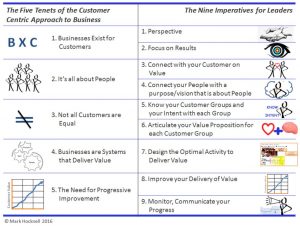
In my previous post, the Five Tenets of the Customer Centric Approach to Business provided a basis that is relevant today of how we should be approaching our work, in building businesses that are relevant and engaging for our customers, and sustainable for the long term.
The following Nine Imperatives for Leaders are derived and demanded from an efficacy of The Five Tenets of the Customer centric Approach to Business.

Imperative 1: Perspective
This first imperative for businesses is about the attitude of the leaders, which then flows into the culture of the business. Put simply it is about Arrogance versus Humility.
If there is arrogance at the leadership level, then this will flow down into a company-wide attitude towards the customer. Customers pick-up on the incongruence between what the business says it is, and how it delivers.
The business landscape is littered with failed arrogant business stories. for example:
• In 2015, the dismal performance of Woolworths (compared to Coles) was displayed in the attitude of the leaders saying, “we believed our internal numbers, we thought the customer must be wrong”. (see this post for more details)
• In 2016 the failure of the Masters chain of stores can be accredited to the arrogant strategy of choking their competitor Bunnings, rather than trying to deliver better customer value. By focusing on the competition they became irrelevant to their customers, costing them around AU$2billion. (see this post for more details)
• Similar story in North America (again in retail) where Target USA launched themselves into the Canadian market. With an attitude of ‘a champion USA team’ that could take over the Canadian market, and “we know this business”. A complication with internal project challenges left them failing to deliver customer value, cost: US$7billion. (the full story here).
The perspective of the leaders is critical to success. A sense of arrogance, that it is all about us, “look at what we can do”, versus the humility of leadership teams that listen to their customers and recognise that without delivering value to the customer, they will soon become irrelevant.
Imperative 2: Focus on Results
This might seem an obvious imperative for management, but I am advocating a definite twist on what is the common practice.
The common practice is that managers and leaders understand the concept of focusing on results, however, what happens in the translation is that they apply pressure on individuals to be “accountable” to reach their targets. Leaders then set the targets, supposedly with the people who have to deliver them, collaboratively. The problem here is that the targets end up being a measure with a target, something like, dollar value of sales $2m, or Net Promoter Score is 16. These are poorly described measures with targets not results. And as a manager I can do lots of things to hit the target (that may include manipulating the measure or the system) but not ultimately achieve the intended result, (such as: our customer base is profitable).
Juggling multiple KPIs (measures with targets) leads us to focus on hitting the number rather than trying to improve the system and processes we are managing.
Let’s put the focus on results. A result then is an outcome we achieve, it is not an action, or a project, it is the result of the work we do. By applying the focus on the results to be achieved we empower people to take ownership on how to achieve their results, the leader’s role then becomes a coach, to encourage learning about how to improve performance.
Imperative 3: Connect with your Customers on Value
Customers today seek value. And even more than ever, customers are seeking experiential value. Today’s consumer invests far more on the experience than in the past.
Similarly in B2B; businesses (most of them anyway) recognise the value of partnership-relationships with suppliers and vendors, they want the expertise and knowledge to be exchanged to enrich their corporate knowledge.
Customers define value in many ways, such as: the goals they seek, the results they want, the experience they desire. Value for customers may also be about belonging to a community and the decisions they make are often influenced by their values and ethics. Customers make decisions emotionally, then seek rational information to support the decision.
Businesses need to connect with their chosen customer groups on value. This means the narrative of the business story needs to include the “why” for customers. Remember, customers do not care what you do. They only care about what you can do for them, and how you can help them get the value they are looking for, in whatever way they express it.
Imperative 4: Connect your with a Purpose and Vision that is about People (customers)
Employees rarely connect with the targets and goals that are about the financial success of the business, the profits to be shared by the “fat cats” or “shiny tails”. People respond well to having meaningful work to do, and goals that are about other people, feeling that they are contributing to outcomes for groups of people, their customers.
By ensuring the vision and purpose of the business is about people (customers), the workforce will more readily apply their engaged hearts and minds to achieving the results that will demonstrate progression towards the vision. Their work will have meaning. Rather than contributing to shareholder returns, or Exec bonuses. They will be engaged in trying to make the world a better place for their customers.
Graham Weston, CEO Rackspace (TEDx) says it this way: “We all want to be valued members on a winning team that is on an inspiring mission”.
Imperative 5: Know your Customer Groups and your Intent with each group
Knowing customer groups is about defining each group, understanding how the two-way value exchange works between you and your customers. Customer groupings are defined by how they behave, their characteristics and what they value. This goes well beyond demographic segments and other neat categories to place prospects in. Your customer groups can also be defined by how the customer responds to the value you offer.
Once you know your customer groups, extend this knowledge to understanding how the two-way value exchange works between you.
Then you need to determine what your intent is with each customer group.-Do you want more of these customers..? Do you need to change the way the relationship works (to reduce cost to serve, or add more value)..? Do you want to end this relationship..? Do not leave the creation of your customer portfolio to random chance.
Translate your intent with each customer group into objectives and results that drive how you plan, implement and learn.
Imperative 6: Articulate your value proposition for each Customer Group
Value propositions need be at two levels. Firstly, there is the value proposition that is from the company itself, the selling business. The customer needs to know, what this business stands for, who are they, what do they value. This level of value proposition addresses the “Why” that Simon Sinek refers to, customers need this as well.
Secondly, there are value propositions at the product or service level, but not about the product or service, they are about the value the customers get from the product or service. Today’s customers seek value and positive experiences – from their products and services as well as from each connection with the organisation.
Too often organisations leave to communication of value to individuals. We need to articulate and communicate the value proposition we have for our customer groups, so that we have a better chance of alignment across the functions and communications, and a better chance of delivering the intended value.
Imperative 7: Design the optimal activity to deliver value
Recognising that the business is really a system (the collection of functions, processes and systems) that, from the customer’s perspective delivers value (or not), businesses need to design the optimal delivery of value from the outside of the business in. Or, as the customer experiences it. And this may not be to every customer, but to the ones who we have chosen, through knowing our customer groups and our intent with the groups.
Align the resources of the business to deliver one thing – the value you have promised to your customers. Aligning your resources maximises the realisation of your results.
Imperative 8: Improve your delivery of value
Your status quo is an evil abode. You have rivals for the attention of your customers. The expectations of your customers are constantly moving, so must you. Especially in how you deliver value and how you engage with customers (new and existing).
We need to ensure:
• Everyone has a clear, line-of-sight view of the purpose, vision and strategy, especially how this creates value for customers;
• Your strategy is translated into a set of results that clearly demonstrates the cause-and-effect flow of the results teams achieve;
• You have measures that provide feedback on the results you are aiming for;
• You allow teams to use these measures to hypothesise, test and learn, how to apply and quantify improvement initiatives;
• Your teams are accountable for pursuing your goals and results – not hitting a set of numbers.
Imperative 9: Monitor and communicate your progress
Monitor is an antonym to ‘set and forget’. Many leaders appear to have a deficit in maintaining attention to the results that will make the business successful.
What’s needed in the business is a focus on the results that are important. Then communications from the leaders to say we are making progress towards those results (or at least we are learning). When leaders change focus (sometimes not intentionally), the people in the business feel the goal has changed, progress is stopped and “what happened to that inspiring mission we were on…?”.
A feeling of making progress visible adds meaning to the work we do.
The veracity of the Five Tenets of the Customer Centric Approach to Business demand the Nine Imperatives for Leaders.
For any business to achieve its ultimate goal and purpose, to be meaningful and relevant long-term to its customers, employees and owners, the Nine Imperatives for Leaders need to be their literal and moral compass.




Absolutely on the money, Mark
I would add working on a Customer mind-set and attitude
Thanks for your comment Gautam. I agree customer mindset and attitude is everything – however it can be a little abstract, which is why I advocate that the purpose is based on what the customer values, and the results for the business are outcomes we achieve with customers. Then perhaps and hopefully, we create a mind-set and attitude that is focused on real outcomes for customers.
Mindsets and Attitudes improve customer value, which we can measure. Customer Value is a real outcome